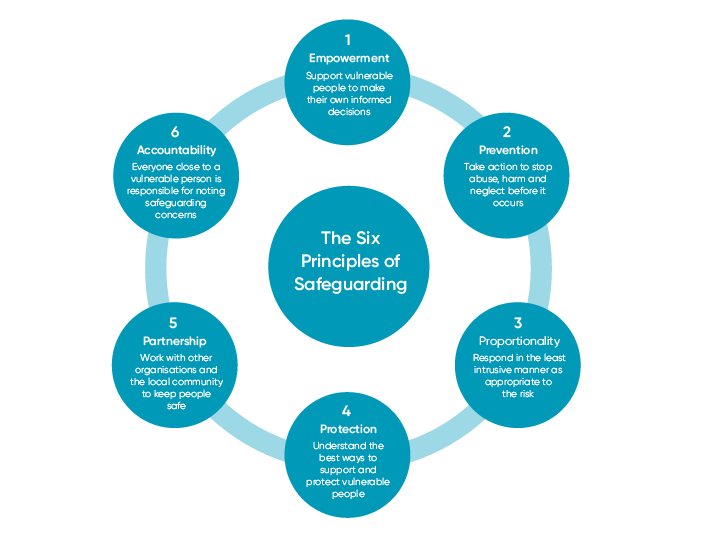The 6 principles of safeguarding explained
The 6 principles of safeguarding outline the best ways to safeguard vulnerable adults. They underpin what safeguarding is all about: ensuring that the health, wellbeing and human rights of children and vulnerable adults are protected.
Understanding what the principles are, as well as how to follow them, is an essential part of keeping vulnerable people safe from harm, abuse and neglect.
The 6 principles of safeguarding are:
- Empowerment
- Prevention
- Proportionality
- Protection
- Partnership
- Accountability
In this blog, we explain what each of these key principles of safeguarding mean. We also outline why safeguarding is so important, as well as how you can ensure a safe working environment where everyone is protected.
What are the 6 principles of safeguarding?

Empowerment
This principle is all about informed consent and empowering vulnerable people to make their own choices. For example, a vulnerable person should be able to give permission for medical treatment with complete knowledge of the potential outcomes.
For a vulnerable person to make these kinds of decisions, you should ensure that they are given all necessary information in an objective manner. Services should also be tailored to the specific needs of the vulnerable adult you are working with. You could, for instance, ask them what their desired outcome to a situation would be and plan your response around their wishes.
As with all safeguarding principles, it’s important to act in the best interests of the vulnerable person. The Empowerment principle ensures that their thoughts, feelings and opinions are taken into consideration. Unless they do not have the capacity to make decisions, as defined in the Mental Capacity Act 2005, they should always have control over their own choices.
Prevention
The saying ‘prevention is better than cure’ rings true for this key principle of safeguarding. Where there are signs that abuse, harm or neglect could occur, it is essential that action is taken to stop a person being put in danger.
To make this possible, it is important to raise awareness of who may be more likely to become vulnerable. For example, a vulnerable adult can include those with mental or physical disabilities, those with chronic or terminal illness, and the elderly.
It is also important to be able to recognise the signs of abuse, harm and neglect. For this, thorough safeguarding training is crucial. Advice and information around safeguarding must also be easily accessible and communicated with others, so that any signs can be recognised and acted on as early as possible.
Proportionality
Ensure that the way you deal with a safeguarding issue is proportional to the risk presented. As a general rule, it is important to respond using the least intrusive method. However, to ensure that a safeguarding concern is dealt with in the most appropriate way, you will need to properly assess the risk presented.
Ask yourself, how likely is abuse, harm or neglect to occur? And how severe is the situation? Some situations may only need a small amount of intervention, whereas severe risks (such as where a person’s life is in danger) would necessitate an urgent, more invasive response. Always act in the best interests of the vulnerable person.
Protection
The Protection principle reiterates the whole purpose of safeguarding: to support those who are vulnerable and protect them from harm. This must be done in the best possible way for the vulnerable person.
Under this principle, organisations and individuals should understand safeguarding processes and best practice. They will need to know what to do if they have a safeguarding concern, how to stop danger from happening or escalating, and how to provide help and support to the vulnerable person who requires it.
Knowledge is power here. Accessible training, education and communication between people and organisations can all help to ensure people know how to deal with safeguarding concerns, and in turn can protect those at risk.
Partnership
The Partnership principle encourages collaboration between organisations and local communities.
Organisations are advised to raise awareness around safeguarding issues. If local communities understand how abuse, harm and neglect can be spotted, prevented, and reported, then vulnerable people living in that community stand a better chance of being protected.
Organisations can also share relevant information about a vulnerable person with other organisations and the local community, as long as it is absolutely necessary to keep that person safe.
Accountability
Everybody has a responsibility to keep others safe. If you are in contact with someone who may be vulnerable, it is your duty to recognise, record, respond and report any safeguarding concerns. This includes if you are that person’s carer, doctor, social worker, or even if you are a friend, relative or colleague.
To ensure accountability, it is helpful to establish clear roles and responsibilities around safeguarding within the workplace. That way, everyone understands exactly what they need to do when it comes to keeping people in their circle safe.
Conclusion: Why are the 6 principles of safeguarding important?
The 6 principles of safeguarding are important for the same reason that safeguarding is important: every person has the right to live free from abuse and neglect. Safeguarding, and the 6 key principles of safeguarding, provide ways that this can be achieved. To recap, this is by:
- Empowering vulnerable adults to make their own decisions
- Preventing harm from occurring as soon as possible
- Responding to risks in an appropriate, ideally unintrusive manner
- Ensuring everyone has the knowledge and training required to protect people from abuse
- Partnering with other organisations and communities to support vulnerable people
- Making sure everyone understands their responsibilities around safeguarding
These principles are critical to prevent abuse and neglect from occurring, while also ensuring the best possible level of care is given. By following the key safeguarding principles, we can be sure that we are doing the best we can to protect vulnerable people from harm.
.
As Digital Content Executive with Ideagen, Donna creates content which delivers value to the reader and provides insights and solutions into the challenges they might be facing. With a strong background in content writing, Donna is passionate about creating quality pieces which resonate with our audience across the digital sphere.


